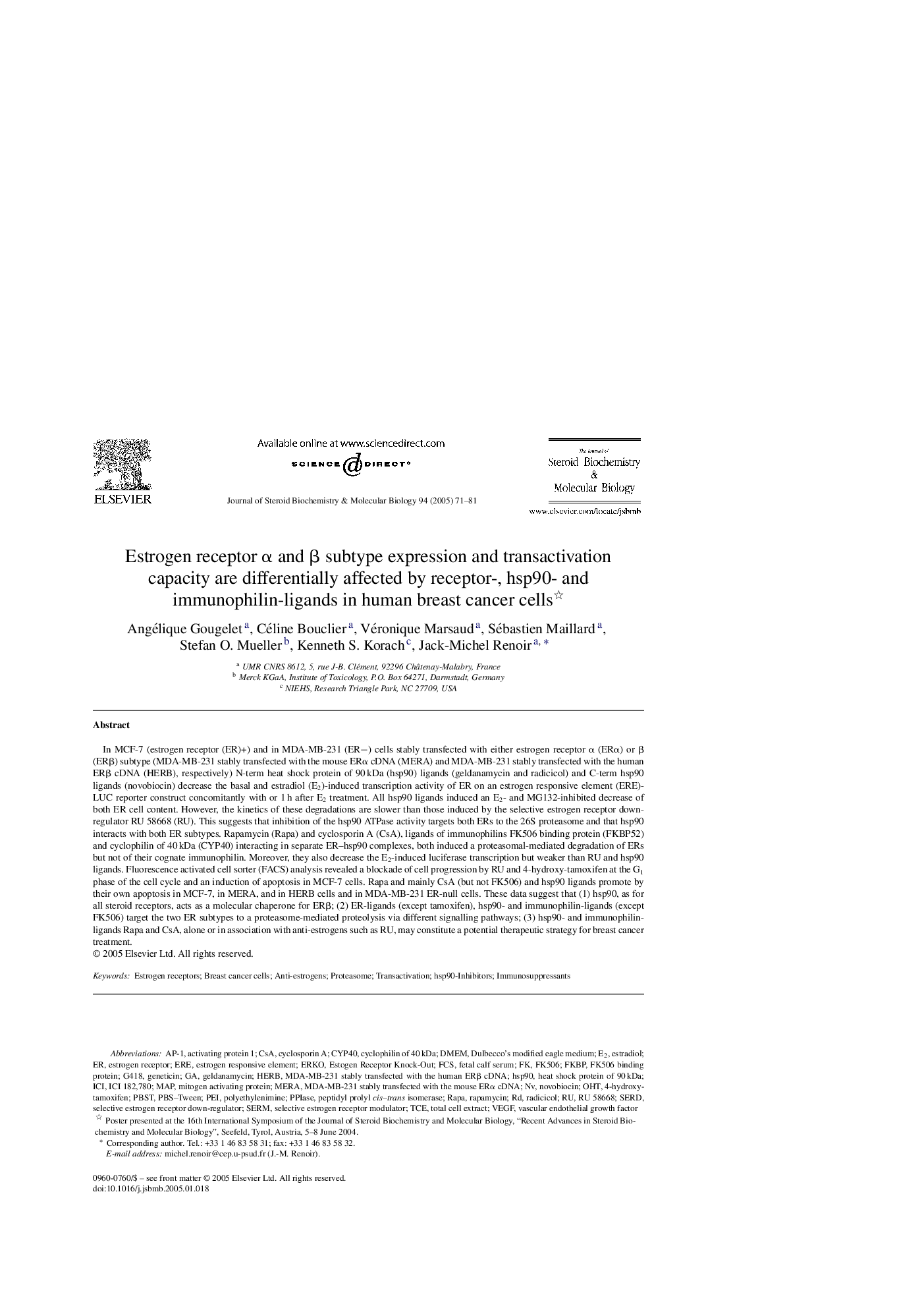| Article ID | Journal | Published Year | Pages | File Type |
|---|---|---|---|---|
| 9892180 | The Journal of Steroid Biochemistry and Molecular Biology | 2005 | 11 Pages |
Abstract
In MCF-7 (estrogen receptor (ER)+) and in MDA-MB-231 (ERâ) cells stably transfected with either estrogen receptor α (ERα) or β (ERβ) subtype (MDA-MB-231 stably transfected with the mouse ERα cDNA (MERA) and MDA-MB-231 stably transfected with the human ERβ cDNA (HERB), respectively) N-term heat shock protein of 90 kDa (hsp90) ligands (geldanamycin and radicicol) and C-term hsp90 ligands (novobiocin) decrease the basal and estradiol (E2)-induced transcription activity of ER on an estrogen responsive element (ERE)-LUC reporter construct concomitantly with or 1 h after E2 treatment. All hsp90 ligands induced an E2- and MG132-inhibited decrease of both ER cell content. However, the kinetics of these degradations are slower than those induced by the selective estrogen receptor down-regulator RU 58668 (RU). This suggests that inhibition of the hsp90 ATPase activity targets both ERs to the 26S proteasome and that hsp90 interacts with both ER subtypes. Rapamycin (Rapa) and cyclosporin A (CsA), ligands of immunophilins FK506 binding protein (FKBP52) and cyclophilin of 40 kDa (CYP40) interacting in separate ER-hsp90 complexes, both induced a proteasomal-mediated degradation of ERs but not of their cognate immunophilin. Moreover, they also decrease the E2-induced luciferase transcription but weaker than RU and hsp90 ligands. Fluorescence activated cell sorter (FACS) analysis revealed a blockade of cell progression by RU and 4-hydroxy-tamoxifen at the G1 phase of the cell cycle and an induction of apoptosis in MCF-7 cells. Rapa and mainly CsA (but not FK506) and hsp90 ligands promote by their own apoptosis in MCF-7, in MERA, and in HERB cells and in MDA-MB-231 ER-null cells. These data suggest that (1) hsp90, as for all steroid receptors, acts as a molecular chaperone for ERβ; (2) ER-ligands (except tamoxifen), hsp90- and immunophilin-ligands (except FK506) target the two ER subtypes to a proteasome-mediated proteolysis via different signalling pathways; (3) hsp90- and immunophilin-ligands Rapa and CsA, alone or in association with anti-estrogens such as RU, may constitute a potential therapeutic strategy for breast cancer treatment.
Keywords
EREPPIaseFK506G418TransactivationPEISERMAP-1ERKOFCSSERDRAPATCECyP40DMEMmitogen activating proteinFKBPPBSTHSP904-Hydroxy-tamoxifenDulbecco's modified Eagle MediumEstradiolCSAICIICI 182,780OHTImmunosuppressantsRADICICOLRapamycinSelective estrogen receptor down-regulatorfetal calf serumBreast cancer cellscyclosporin AAnti-estrogensEstrogen responsive elementVascular endothelial growth factorVascular Endothelial Growth Factor (VEGF)activating protein 1Selective estrogen receptor modulatormerAmapNovobiocinProteasomeFK506 binding proteinPolyethylenimineGeneticinGeldanamycinHerbEstrogen receptorestrogen receptors
Related Topics
Life Sciences
Biochemistry, Genetics and Molecular Biology
Biochemistry
Authors
Angélique Gougelet, Céline Bouclier, Véronique Marsaud, Sébastien Maillard, Stefan O. Mueller, Kenneth S. Korach, Jack-Michel Renoir,
